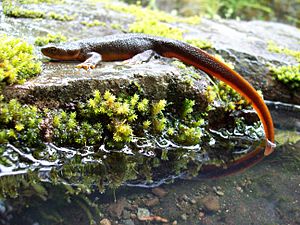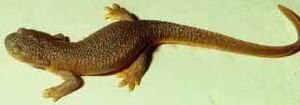Rough-skinned newt facts for kids
Quick facts for kids Rough-skinned Newt |
|
|---|---|
 |
|
| Conservation status | |
| Scientific classification | |
| Kingdom: | |
| Phylum: | |
| Class: | |
| Order: | |
| Family: | |
| Genus: | |
| Species: |
T. granulosa
|
| Binomial name | |
| Taricha granulosa |
|
The rough-skinned newt (Taricha granulosa) is a special type of newt found in North America. It's well-known for having a strong natural toxin in its skin.
Young newts live on land for about four or five years after they change from water creatures. Adult newts can live both in water and on land. They lay their eggs in water, and you can often spot them after a lot of rain.
Contents
What Does the Rough-Skinned Newt Look Like?
This newt is quite sturdy with a rounded nose. Its back can be light brown, olive, or brownish-black. But its underside, including its head, legs, and tail, is a bright orange or yellow. Its skin feels bumpy, like small grains. However, during the time they breed, male newts have smooth skin.
Rough-skinned newts are usually about 6 to 9 centimeters (2.4 to 3.5 inches) long from their nose to their bottom. Their total length, including their tail, is about 11 to 18 centimeters (4.3 to 7.1 inches). They look a bit like the California newt (Taricha torosa). But rough-skinned newts have smaller eyes, yellow eye centers, and dark eyelids.
How Does the Rough-Skinned Newt Protect Itself?
Many newts have a toxin in their skin to stop other animals from eating them. The rough-skinned newt is especially poisonous. This toxin is usually released only if the newt feels threatened. Sometimes, just touching a newt can cause skin irritation.
If a human were to swallow the toxin from a rough-skinned newt, it could cause serious harm. It can make a person unable to move or even be deadly. This is why it's important to never put these newts in your mouth.
How Some Snakes Can Eat Newts
In many places where the rough-skinned newt lives, a snake called the common garter snake (Thamnophis sirtalis) has learned to resist the newt's toxin. This means these snakes can eat the newts and survive. In fact, toxin-resistant garter snakes are the only animals known today that can safely eat a T. granulosa newt.
This is a great example of co-evolution. This is when two different species change and adapt to each other over a long time. The garter snake's ability to resist the toxin has made the newts produce even stronger toxins. Then, the newts' stronger toxins make the snakes develop even greater resistance.
This back-and-forth change between a predator and its prey is sometimes called an evolutionary arms race. Because of this, rough-skinned newts now make much more toxin than they would need to protect themselves from any other animal.
Why Newts Have Bright Colors
Toxic animals often have bright colors to warn predators that they are dangerous to eat. There's no point in being poisonous if animals don't know to stay away. The rough-skinned newt's underside is a very bright yellow-orange. When a newt feels threatened, it curls its tail and lifts its head. This shows off its bright warning colors, telling predators to stay away. You can see this in pictures of the newt.
Where Do Rough-Skinned Newts Live?
Rough-skinned newts live along the west coast of the United States and in British Columbia, Canada. Their habitat stretches from California in the south all the way up to Alaska in the north.
Images for kids
See also
 In Spanish: Salamandra de piel rugosa para niños
In Spanish: Salamandra de piel rugosa para niños







